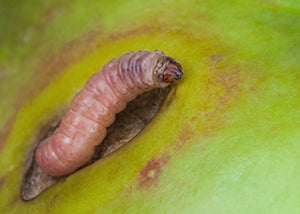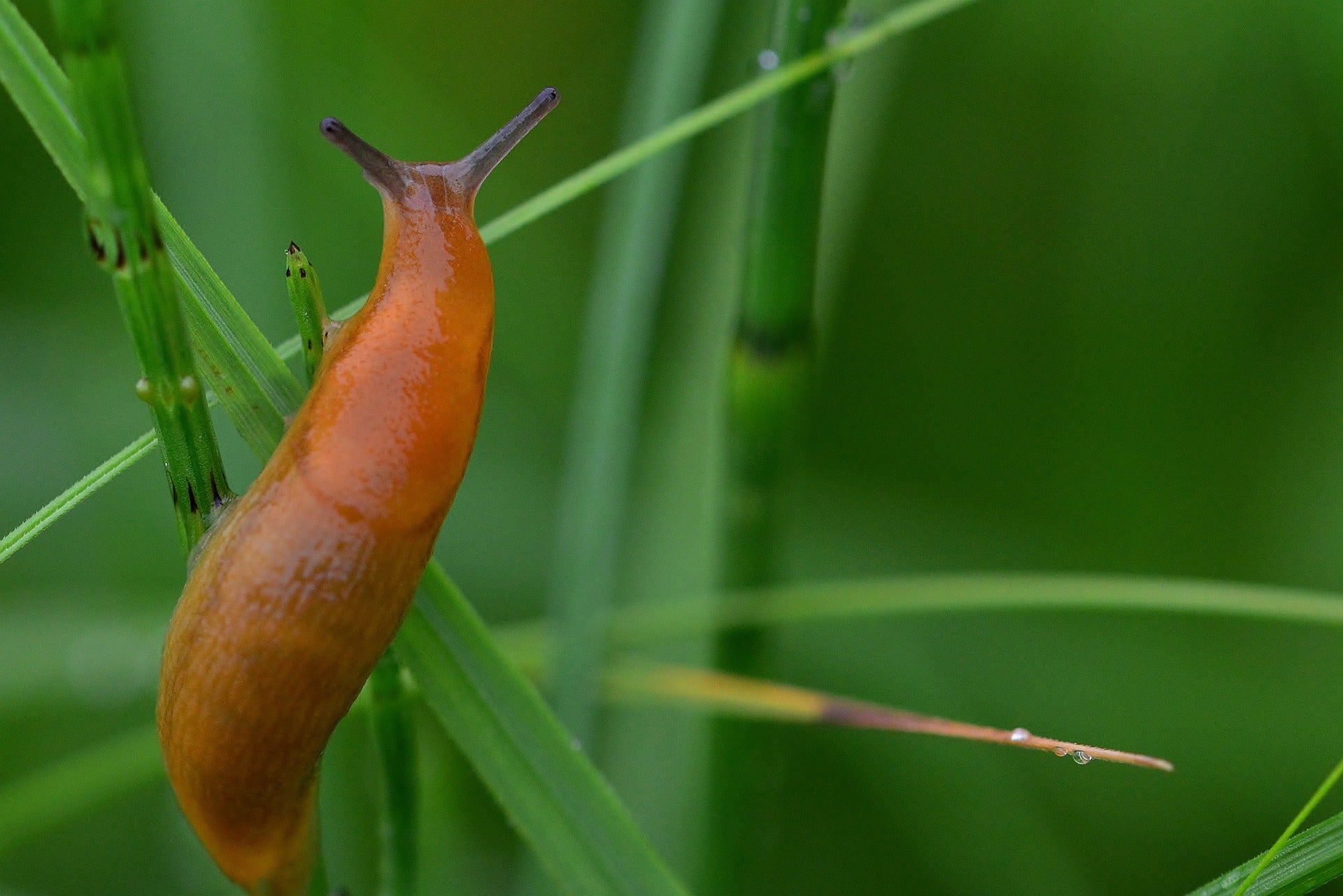Codling moth control Codling moth is the main cause of maggots in apples and pears, ruining your fruit. Pheromone traps, followed by nematodes and insecticide sprays are common options for codling moth control.
What is codling moth/maggots?
Codling moth is the adult form of the codling moth maggot, which is the main cause of maggot damage in apples and pears.
The codling moth lays tiny single eggs dotted around the leaves and on the surface of the fruit, which then hatch into tiny caterpillars, i.e. maggots, just 1mm in diameter.
The maggots burrow into the middle of the apple and pear to eat the seeds. They later burrow into the bark of the tree (or other sheltered places) to spin their cocoons and become pupae, which eventually emerge as moths in Spring.
When are codling moths active?
Codling moths emerge in Spring and start to lay eggs, so the maggots can do their damage during Spring and Summer. The maggots can overwinter in the bark, surviving and hatching into a new set of moths the following year.
As temperatures increase, the active season for codling moths is extending.
Codling moth identification
The adult codling moths are dark brown with very fine wavy stripes of lighter brown. There are also brown ‘eyes at the edge of the forewings. The antennae are slender and curved.
When resting on a surface, the moth is quite distinct with a ‘tent’-like shape with it’s folded wings.

Picture of codling moth
The caterpillar form is tiny, just 1mm in diameter. Codling moth caterpillars turn from white to pink in their lifetime. They have tiny brown heads.

Codling moth caterpillar picture
Are there codling moth on plum trees?
Plum trees suffer from plum moth instead of codling moth, which is a related but different species and needs slightly different control. Please find more information about plum moth here.
Can you eat apples with codling moth?
In theory you probably can, as long as they’ve not fallen to the ground as they could then have picked up nasty bacteria off the ground or passing animals which could make you really sick (for example, animal droppings containing E. coli bacteria).
The maggots themselves are not toxic to humans, though most would find the idea of eating them completely disgusting. And it’s true that they taste unpalatable once they start to rot.
Many compromise by making the apples into other things, like apple sauce or cider.
What are the signs of codling moth?
Maggot damage in apples
Spots on the outside
The apples or pears will often have odd spots or holes on the outside where the maggots have burrowed in. These then rot quickly. However, the holes aren’t always visible.

Maggot spots
Damage on the inside
Once you cut open the fruit, the full extent of the damage is revealed! You will find dark brown ‘tunnels’ where the maggot has burrowed toward the centre of the fruit to eat the seeds. You may even find the maggots still inside the apple.

Maggot damage in apples
Early ripening and dropping fruit
The fruit will ripen and drop from the trees early due to the damage caused on the inside. This may be the first symptom you notice.

Early ripened and dropped apples
Codling moth control
So, how do you control a codling moth infestation? The best way is to set up pheromone traps, and then apply nematodes or a spray if necessary.
Codling moth traps
These are pheromone traps that use the scent of the female moth to attract male moths into the trap. Once inside, they get stuck on the sticky surface and die.

Codling moth trap
The great thing about these traps is they’re natural, not using any pesticides or toxic chemicals. They also only attract and kill codling moth; all other moths, butterflies, bees and beneficial insects contributing to the delicate balance of your ecosystem of your garden are unaffected.
You can also check the sticky inserts regularly to see how many moths have been caught. In this way, you can put them up every Spring to check whether any caterpillars have been lurking in your bark over winter and alert you to the problem early.
You can also use them to see exactly how much of a moth problem you have. At low levels, these traps will be enough to deal with the problem by themselves. At higher levels, you might need to add in nematodes or a spray treatment as well.
Set up these traps when codling moths are active, in Spring and Summer (May-September).
Nematodes
Nematodes are another natural, organic control. They are microscopic worms that are natural parasites of codling moth caterpillars. Again, they only target codling moth.

Nematodes
Nematodes normally come in a powder that should be mixed with water and sprayed on the trunks, branches, and ground around the trees (where the caterpillars might be located).
Nematodes should be sprayed September-October, when the codling moth caterpillars have retired to the trees getting ready to transform into moths.
Insecticide spray
Pesticides are not ideal due to their damage to the environment (and human health).
Best insecticide for codling moth
Try to use shorter-persistent pesticides that break down more quickly and cause less damage.
In order to be effective, the whole tree must be thoroughly drenched in pesticides. So this treatment is not worth it for larger trees.
- Shorter-persistent pesticides include Neudorff Bug Free Bug and Larvae Killer, and Bug Clear Gun for Fruit & Veg
- Longer-persistent pesticides (which contain harmful synthetic pyrethroids like deltamethrin, lambda-cyhalothrin and cypermethrin) include Provanto Ultimate Fruit & Vegetable Bug Killer, Py Bug Killer and Westland Resolva Bug Killer.
Use a pheromone trap to alert you when to spray.
Encourage natural predators
Another long-term option is to try to entice natural codling moth predators into your garden, such as birds (particularly Blue Tits), ground beetles and hedgehogs. Earwigs also eat the larvae, and other fruit aphids, but they can damage damage flowers like clematis, dahlia and chrysanthemums.
- Blue Tits: put out peanut feeders high up in your garden, bird houses with small holes, and bird baths
- Hedgehogs: put out hedgehog food, create hedgehog holes and tunnels for them to roam freely between gardens, and place ramps on the edge of your pond
- Ground beetles: plant beetle banks, place stones and logs, and put out gravelly shallow water and night lights

Hedgehog
Related Products
CODLING MOTH TRAP

A natural pheromone trap that catches codling moths. Free next day delivery.
CODLING MOTH REFILL LURE

Natural pheromone refill for a codling moth trap. Free next day delivery.



